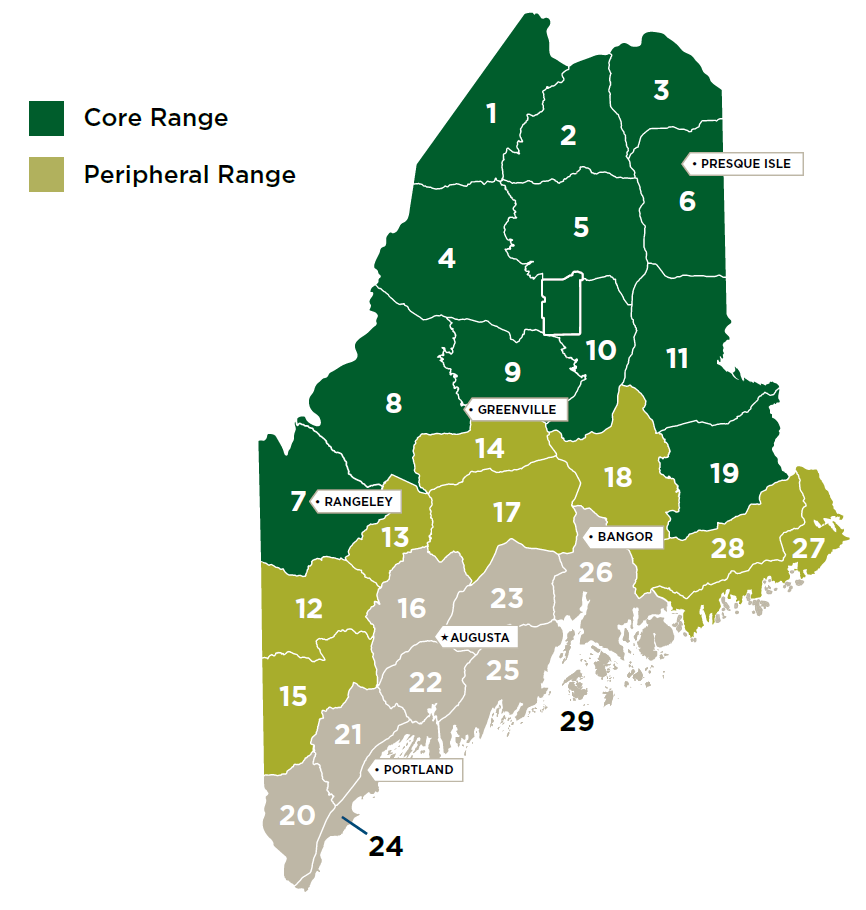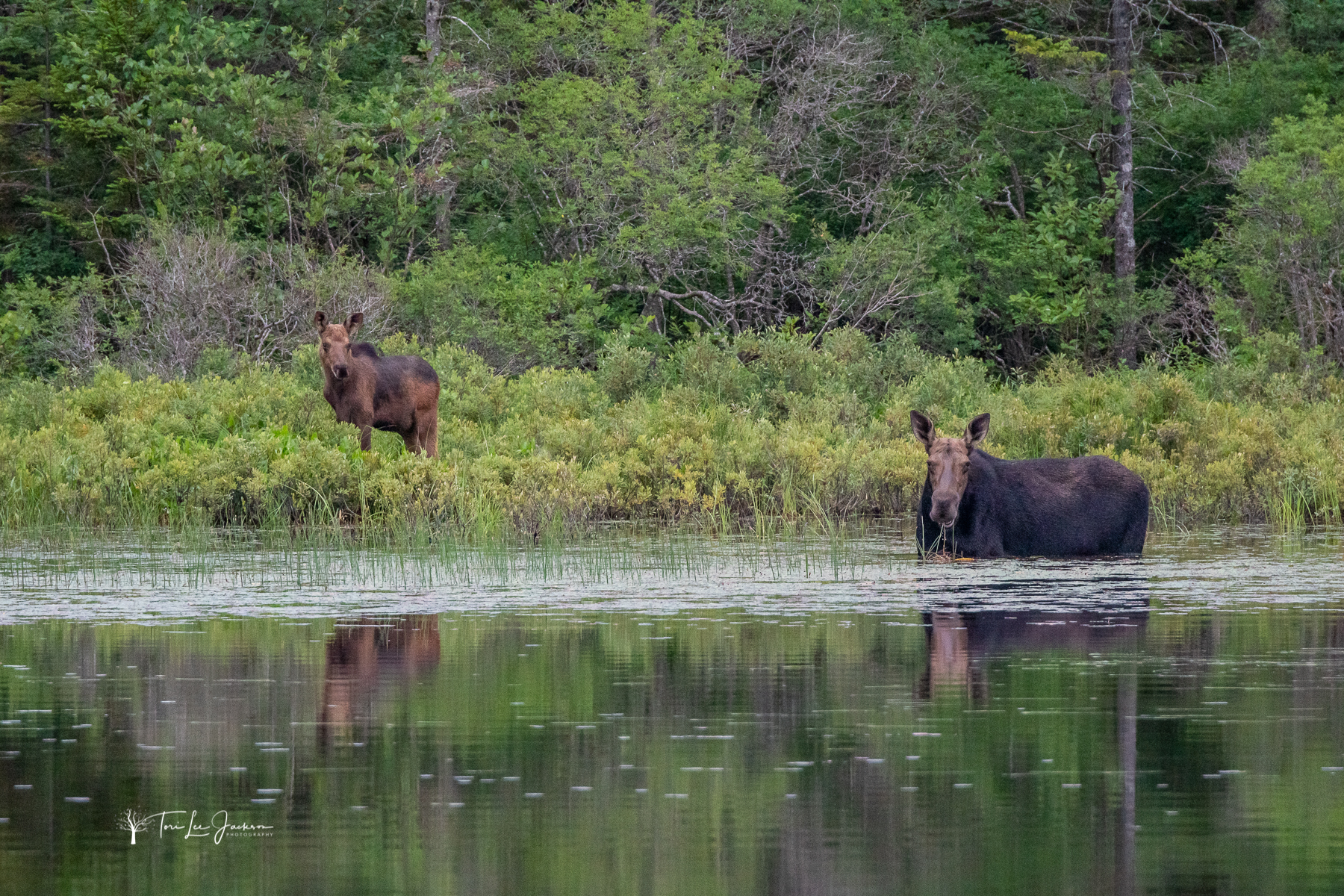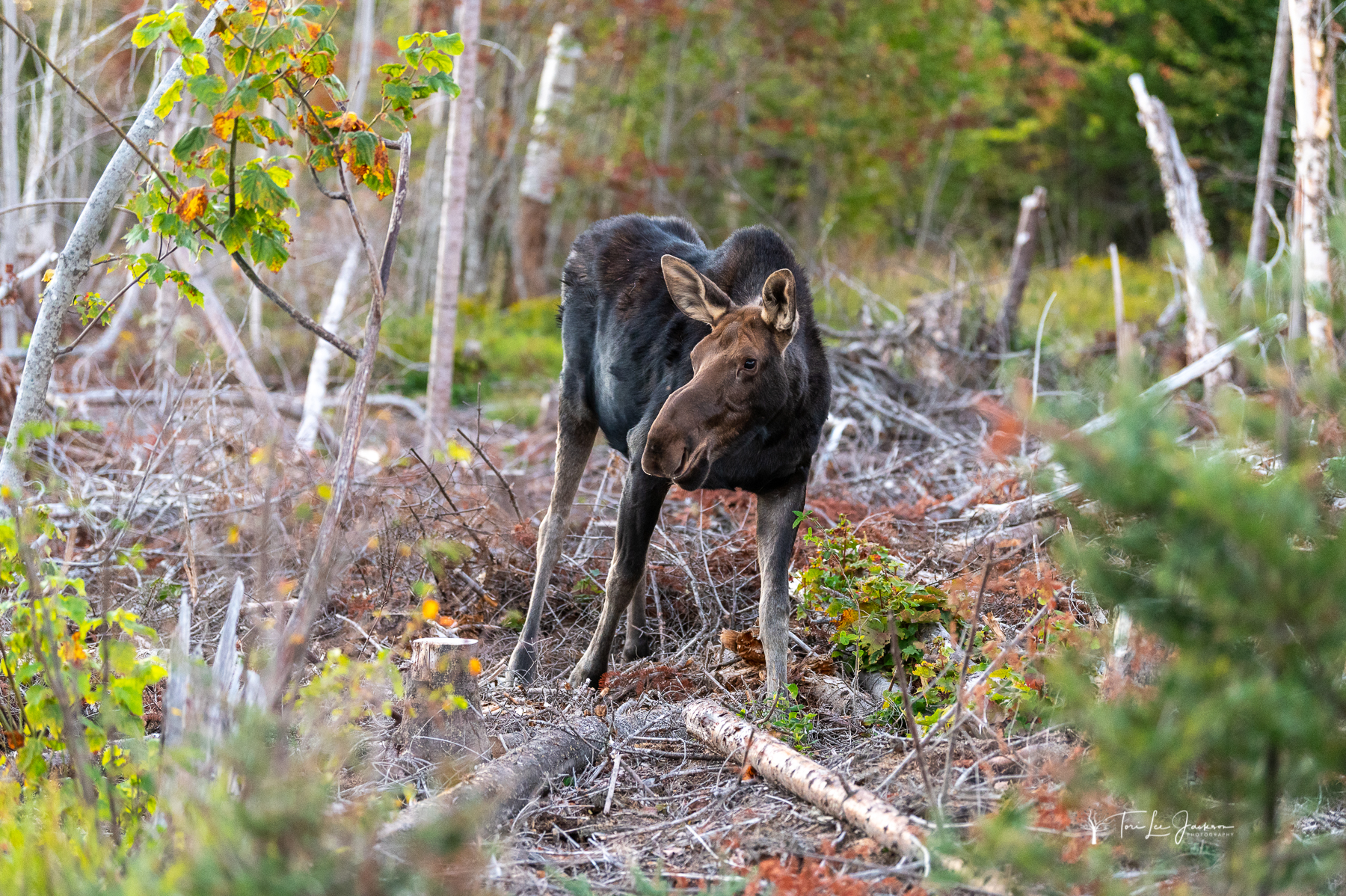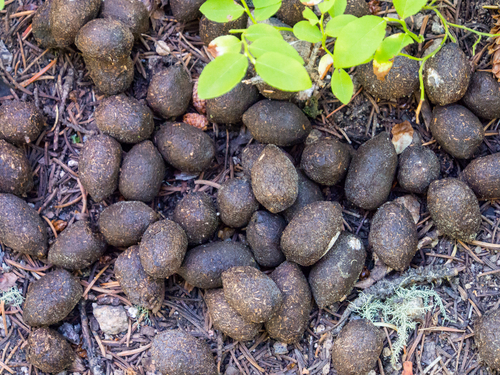July 7, 2025 at 11:01 am
Moose are the icons of the Maine woods.
With a population of 40-60,000 moose, Maine is home to the largest population in the lower 48 states and is an excellent place to see your first moose… if you’re willing to put the work in!

Standing up to seven feet tall and weighing 800-1,100 pounds on average, males being larger, they are a sight to be seen. Wading through the water, peaking through spruce, or against vibrant fall foliage. But just what should you consider when exploring Maine, in hopes of spotting this majestic creature?
Location, time of day, and season are three major considerations. Combine that knowledge with a little luck, patience, and maybe some black flies, and you may have a memorable moment watching this giant mammal.
Moose are most likely to be seen in northern and western Maine in their core and peripheral range (see map to right), although they may be seen statewide, so always keep an eye out!
Summer

During the summer months, moose seek out and spend a lot of time in water. Rivers, streams, ponds, lakes, bogs…you can’t turn around and throw a stick without hitting water. Moose use these places because aquatic vegetation is rich in sodium (which moose crave and require in their diet). But just because moose use these places, doesn’t guarantee the timing will work out. Moose will feed for short bouts, then move back into the woods for shade and to ruminate (digest). Timing, location, and luck is critical to spotting a moose. While early mornings and late afternoons seem to be more habitual for movement of moose, they are constantly eating, ruminating, and bedding throughout the course of a 24-hour day. So, finding a likely place for moose to feed is a big step, then being there when the moose is there is another. Some persistence is important and checking in at good locations often may eventually yield success. Once vegetation dies back at the onset of fall, moose have little reason to visit waterbodies and spend more time in young upland sites where there is plenty of young forest growth—a delicious buffet for moose! A young upland site, also known as a young forest or early successional habitat, is an area of the forest with dense regrowth of young trees, shrubs, and grasses, following a disturbance such as logging, fire, or clearing for agriculture. Like all animals, moose are ultimately seeking to balance the necessities of feeding requirements, the safety and security of hidden areas, and the cool temperatures given by shaded forestland.
Fall
As summer comes to a close and fall begins, so do the hormones associated with the rut, or breeding season. At this point, moose are more active in seeking a mate, traveling around their ranges more, and checking in on other moose. Since moose are moving more, it may provide a higher potential to see these animals. Of course, since fall is hunting season and biting bugs are on the wane, more people are on the move too, driving the roads and enjoying nature, but ultimately giving behavioral cues to moose to shy away of roads and clear-cuts, and push further into the woods. Thus, getting off “the beaten path” and away from other people is important to finding and seeing moose. This requires studying the lay of the land, finding food resources (young forest stands) adjacent to water bodies where you might be able to walk into or launch a boat, and putting in the extra effort of walking into the woods.

Winter
By winter and after the rut, moose are feeding more in forest cuts and beginning to spend more time in softwood (coniferous trees like balsam fir) and mixed wood stands (areas with both coniferous trees and hardwood trees like maple). In these months, snowmobiling recreators will be the ones to see more moose, Once the snow comes and trails are groomed and ridden on, these will become places that moose like to travel, taking advantage of the man-made corridors and avoiding deep, challenging snow conditions. If you see moose on the trail, please give them lots of space and time to get off the trail. Upon coming up to a moose, stop and wait for them to move off the trail, and enjoy the unique opportunity of observing one of these unique animals.
Signs of Moose:
As you scout for places you think you might spot a moose, keep an eye out for sign indicating their presence:
Tracks: Mose tracks are large, ranging from 4-6” long and 3.5-5” wide. Like deer, the pointed end of the hoof is the direction that the animal is traveling.
Scat: Moose scat (poop) depends on the season and foraging. During winter months, scat is usually a pile of pellets about 1-1.75” in length. During spring and summer months, scat will likely have more moisture and may result in softer pellets or a single patty.

Browse: Moose have no incisors on the top of their mouths, only on the bottom, causing them to tear and scrape at herbaceous material, leaving it torn and rough.
Rut Pits/Wallows: Moose will use their front hooves to dig into the ground, creating a rut, then urinate into the pit. This is done during the rut (mating season) by bulls to attract females for mating. The pits are usually several feet long and wide.
Barking: Moose are known for scraping maple trees with their incisors in an upward motion to feed on the cambium layer.
Antlers: Males have large, palmated antlers during the mating season that they shed and regrow each year. The antlers help show their dominance and protect their eyes when competing for a mate. During the winter months, moose will drop their antlers on the landscape, referred to as sheds. Dropping their antlers helps them conserve energy during the cold winter months.
Respectful Wildlife Viewing Reminders:
-
Always keep a safe distance – the best compliment wildlife can give is if they don’t react to your presence. If they do, you are too close and need to slowly back away. Pack binoculars for a better view!
-
Keep your presence unknown by being quiet and avoiding loud noises or sudden movements – don’t slam your car door!
-
Never feed wildlife.
-
Be mindful of breeding seasons – animals may become more aggressive during breeding seasons, so it’s best to give them extra space. For moose, this is late September into early October. Additionally, if an animal has young, keep a further distance to prevent the mother from becoming stressed.
-
Leave no trace – always pack out what you packed in. Don’t leave food, trash, or any other materials.
-
Keep pets on a leash.
-
Be aware of your location – Always tell someone where you’re going. Be conscientious of where you park (i.e. – don’t park on the side of a busy road) and be respectful towards private landowners. Roughly 94% of Maine's forest land is privately owned, and more than half of that land area is open to the public. Respect private land owners, and always ask permission.
- Share these tips with others!
Respect Private Landowners and Working Forests:
There are plenty of tarred roads in Maine where you might spot a moose from the road, but if you’re seeking an off-the-beaten-path expedition, know that the dirt roads you are driving on are likely owned and maintained by private landowners and logging companies. These private entities built and maintain these roads, and generously share the roads and land with hunters, anglers, wildlife watchers, birders, and other outdoor enthusiasts. This gives outdoor enthusiasts access to thousands of acres of land, lakes and ponds, and miles of rivers. This access is an incredible gift, not a right. When driving on dirt roads, respect landowners:
- ALL LOGGING TRUCKS AND OTHER COMMERCIAL VEHICLES HAVE THE RIGHT OF WAY. PLEASE PULL OVER WHEN MEETING THESE VEHICLES.
- Travel at posted speeds but no more than 45 miles per hour. Some private land areas may have different speed limits.
- Keep to the right when approaching a corner or cresting a hill. Do not expect logging trucks to move out of the center of the road.
- Keep your lights on at all times due to the decreased visibility from dusty roads.
- When dusty conditions exist, please wait for the dust to clear before proceeding.
- When approaching active equipment near the roadside, wait for acknowledgement from equipment operators before proceeding to pass.
- Stay clear! NEVER block roads. Do not leave vehicles in the middle of the road when looking for moose and never park in front of gates or roads.
- If you have a MURS radio, use it to monitor and call out mile markers to on-coming truck traffic.
- Reduce speeds on freshly graded roads - you are more likely to blow a tire or loose control because of gravel.
And remember, many of these lands including North Maine Woods, are a working forest, one where harvesting and logging is the primary reason moose are so happy with habitat in Maine’s northern woods. The process of cutting wood and making forest products creates a diverse forest of different aged stands and provides lots of food for moose. It also means the forest is always changing, and moose are constantly moving in search of new food resources. It’s these ever-changing forest stands that may be the reason you don’t see moose in a location that you once did 20 or more years ago. Think like a moose!
Learn More
And if you want to be guaranteed to see a moose in Maine, visit the Maine Wildlife Park in Gray.
Learn more about moose, moose management and research, and more at mefishwildlife.com/moose